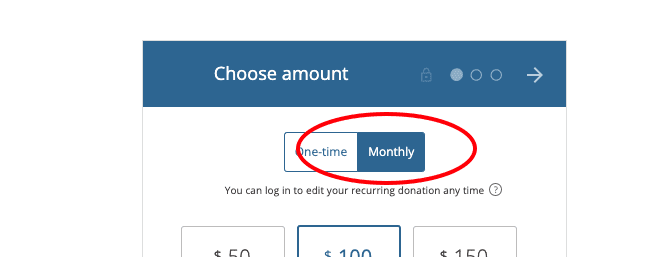Recurring giving will streamline and simplify the givers' process. We'll show you 3 proven ways.
Giving financial donations is one of the oldest topics in the Church. People have wrestled with how much to give, when to give, and where to give their finances since the beginning.
That said, the last thing churches want to do is put up roadblocks once someone has decided when, where, and how to give their money.
With so many giving tools at our fingertips these days, church leaders must do everything they can to streamline and simplify the giving process — especially for those who give on a consistent basis.
Setting the Tone for Recurring Giving
Giving is a huge part of the Christian life. In fact, we’re called to give our time, our effort … and our money. Giving tithes and offerings to the church is a huge part of our walk with the Lord.
Now, to be clear, this isn’t because Christianity is a “pay your way” religion. On the contrary, we’re all living a faith-first lifestyle.
What’s that old line in James, though? Faith without works is dead (James 2:20b.) True faith naturally leads to an outward manifestation in the form of genuine, loving, God-directed works. And, in a world driven by money, these “works” are often centered around giving our hard-earned cash.
Again, this giving shouldn’t be done as a way to “earn your way” or anything like that. As Paul says in 2 Corinthians 9:7:
“Each of you should give what you have decided in your heart to give, not reluctantly or under compulsion, for God loves a cheerful giver.”
DIRECTED GIVING
This leaves it in the hands of individuals to direct their giving. Some will make occasional gifts to your ministry. And others will give regularly but in different amounts. In addition, there are going to be those who have steady incomes and giving habits and who, by extension, give the same amount all year long.
Having a good online giving resource on your church website is a great way to accommodate all of these givers. You can also offer:
- Third-party giving portals
- Directions to set up direct deposit
- Info for mailing paper checks
When it comes to cyclical givers, though, there’s one other thing that you want to address: setting up recurring giving options.
Here are a few important ways to ensure that you are enabling your recurring givers on your website.
3 Proven Ways To Seamlessly Promote Recurring Giving
1. Include a Recurring Option on Every Giving Page
Sometimes your giving page on your website is sweet and simple — especially if you’re running a smaller church. You can pop up a PayPal donate button, add an address to mail checks, and call it a day.
In many cases, though, the giving page is a bit more complicated. You might have text-to-give instructions, multiple donation portals, pledge options, and so on. Each of these has the potential to open up into its own dedicated web page, too.
As you set up your giving pages, it’s important to include a recurring giving option on each and every one. If someone is loading credit card information, offer right then and there to make things easier next time through a recurring payment. Similarly, if they’re looking for a way to send a check, include a CTA (call to action) encouraging them to set up direct deposit. You get the idea.
Normalize tech: 3 Creative Ways to Encourage Technology Adoption Among Churchgoers
Include a recurring giving option on every page in your church's giving section. Also find ways to capture the check writers by encouraging them to set up a direct deposit. Click To Tweet2. Use Your Email to Draw Attention to Recurring Giving
Your church email list is a powerful tool. It gives you a direct line of communication, not just to your congregation, but to the members of your congregation who have proactively opted in to hear what you have to say.
You can use your email list for many useful activities. With it, you can recruit volunteers, announce events, send newsletters, promote recurring giving, …and show gratitude.
The important thing here is to remember that you aren’t requesting more giving activity. Remember, you’re talking to the members of your church body that already are very likely giving on the regular.
Instead, use your email list to simply draw attention to your recurring giving setup. Consider creating a sequence of emails that do the following:
- Explain that you have a recurring giving option.
- Outline the benefits that recurring giving offers (e.g. time-saving, less hassle, etc.)
- Describe how recurring giving works.
- Give a clear CTA prompting the reader to set up recurring giving right from the email.
Email is a great way to inform and empower your congregation regarding the power of recurring giving.
Don't be afraid to use email to remind attendees of your church's giving options. Remember: you aren't asking for more activity, just providing links and easy access to giving tools. Click To Tweet
3. Use QR Codes to Streamline the Process
As the one promoting recurring giving, it’s important to keep in mind what you’re asking people to do. You may be aware of the potential of their saving time and effort in the future, but to your congregants, you’re asking them to put in extra time in the here and now.
You’re also asking them to go out of their way to tackle a new piece of technology. This can make the proposition of setting up recurring giving sound like a hassle — and a bit overwhelming, to boot.
One of the best ways to reduce this barrier to entry is by creating a QR code for your recurring giving sign-up form. QR codes are a great way to get the right links to someone without sending them hunting around on your website.
By creating a QR code, you send the message that you’ve done everything possible to clear the runway for them to set up recurring giving. Sure, your donors still have to put a little leg work in on their end, but they’ll start the process knowing that you’re doing your level best to help them along the way.
Great ideas: 10 Useful End-of-Year Giving Campaign Tips
Reduce more giving barriers by creating a QR code for your recurring giving sign-up form. Instead of hunting around the website, users are quickly taken to the exact page. Click To TweetCashing in on the Benefits of Recurring Giving
Recurring giving is beneficial for the giver and receiver alike. As the latter, having lines of recurring giving set up gives you peace of mind and a certain level of predictability. You can see at least a portion of your future income with relative certainty. This can make it easier to make decisions, sign off on projects, and so on.
As far as your givers are concerned, having a recurring giving option takes a lot of the grunt work out of the equation. They don’t need to re-input information every time they log on to donate. Also, they don’t have to worry about remembering to do so every week. Donors even save time by having the whole activity outsourced and automated.
The problem with recurring giving is connecting with your givers to set up the system the first time around. As is the case with any cyclical activity, 99% of the effort comes in the setup phase. The easier and more accessible you can make that initial process, the more people you’ll convince to sign up for recurring giving in your congregation.
MAKE OPTING IN SIMPLE
So, review the steps above and then audit the giving section of your website. Are you bringing attention to recurring giving in other areas of your ministry, like your email list? Do you offer recurring giving options in enough places? Are you streamlining and jumpstarting the process through things like QR codes?
It’s the little tweaks and prompts like these that can make all the difference as you promote recurring giving to your church congregation.







